HOW TO - Learn Japanese Lyrics 🎶 The Ultimate Guide
How To Learn Japanese Lyrics // Your Ultimate Guide
DID YOU KNOW – you can genuinely learn Japanese by studying Japanese lyrics?! It can be done, and here’s how.
There are many ways to expand your Japanese knowledge. Reading articles, taking classes, talking with natives, etc!
While studying Japanese, it’s important to find subjects that spark your interest and help you feel motivated to challenge yourself! It’s also vital to study actively so that your language learning brain is fully engaged!
A fun way to improve your writing, vocabulary, comprehension, and even your karaoke repertoire is by studying Japanese song lyrics!
With various genres of Japanese music to choose from, you are sure to find an artist that inspires you to learn all their lyrics!
Most of my song examples come from my favorite singers~~ They got me hooked on learning their lyrics!
Let’s dive into 5 steps on how to study Japanese lyrics! Maybe you’ll even find a new artist to learn from today!
How To Study Japanese Lyrics | Find the Original Lyrics
How To Study Japanese Lyrics | Lay Out The Lyrics
How To Study Japanese Lyrics | Furigana for Kanji
How To Study Japanese Lyrics | Study the Lyrics
How To Study Japanese Lyrics | Comprehending the Lyrics
How To Study Japanese Lyrics | Summing Up
How To Study Japanese Lyrics | FAQ’s

How To Learn Japanese Lyrics // #1 Find The Original Lyrics
I’ve learned to hum along with many songs and mud my way through what the lyrics sound like, but everything changes when you devote the time to really learning the right words!
First off we’ll need to find those original lyrics!
Look Them Up Online
You can look up the song’s name, artist, and then the word for ‘lyrics’ in Japanese.
歌詞 かし kashi = lyrics
This provides options for the full song lyrics in it’s original Japanese.
Want Romaji? Sometimes looking up a song in English will give you Romaji lyrics. Many anime opening songs may come up first in Romaji as a good example.
Let’s take the song BLUE BIRD as an example.
When I search “naruto blue bird song lyrics” on Google, I am faced with the lyrics of the whole song in Japanese script. No good if I cannot read them.
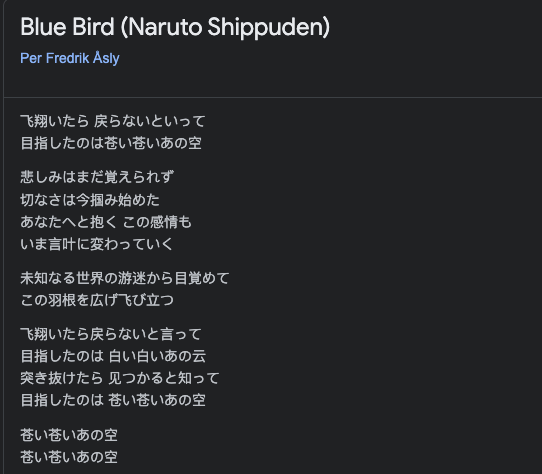
No problem though, as the next result after that is this.
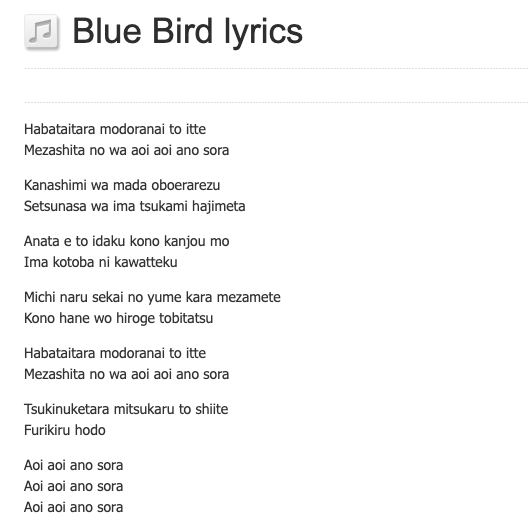
For reference here is the song by the way!
Hwwever, in my own experience, (10 years ago) before I learned Hiragana and Katakana, I used Romaji lyrics so I could try and sing along with the D.Gray-man anime opening songs, but I didn’t actually learn what I was saying.
Still love Lavi though❣️ (anime reference)!
But since our goal is to really learn Japanese through lyrics, I suggest avoiding Romaji and getting the original lyrics to the song you’re studying! We’re going all in!
How To Learn Japanese Lyrics // #2 Lay Out The Lyrics
Now that you have a digital source for the original song lyrics, we need to lay them out for learning!
This is where we organise the lyrics so we can efficiently study them!
Size of Font
The original font size may be a little small and hard to read, so I suggest enlarging it to see the Kanji more clearly!
Speed of Song
Sometimes singer’s are a little hard to understand, or they’re singing is really fast (I’m looking at you 米津玄師 Yonezu Kenshi)
(Thankfully) Youtube gives the option to change the playback speed through settings, so don’t be shy to slow down a song as you’re studying the lyrics!
It really helps, go on, try it on the video above by clicking the settings button.
Get It On Paper
Getting the lyrics from a computer screen onto a piece of paper is an important part of the learning process!
Here are 2 ways to do it.
WRITE IT OUT – This is a great way to get some writing practice and to start processing the lyrics!
It may take some patience, but it’s worth it!
I suggest using an erasable pen (you know those cool Japanese ones) in a dark colour that sticks out.
A method that I have found helpful to challenge myself is to try writing line by line, rather than one character at a time.
This helps to actively write rather than just copying down what you see.
Let’s take an example
アイデア Aidea (Idea) by 星野源 ほしのげん Hoshino Gen
The first line of the song is おはよう 世の中 which translates to Good morning, world.
See how I laid it out in my notes here:

Note also how big I write, this is deliberate.
When writing this out on paper, instead of writing each hiragana separately, try to write おはよう out all together. Then try to remember the next line and only reference the digital lyrics when you need reminding of what come next.
It’s like quizzing yourself on your comprehensive writing skills! Singing as you write the words out can help you remember too, if you like to belt out a song to yourself!
When a difficult Kanji inevitably come up, I would suggest referencing the app ‘imiwa?’ Or a Kanji teaching website to go over the correct stroke order!
Remember, we’re just focusing on writing out the foundation for studying in this step, so don’t worry about the words you don’t know yet! We’ll get to those soon enough!
TOP TIP: Don’t have your lyrics too far away from your writing paper so you’re not straining your neck or getting dizzy looking back and fourth so many times…
Print It Out
If the Kanji are very intimidating or you’re pressed for time, this may be more practical than writing it all out by hand.
Let’s take another example:
フラミンゴ Flamingo by 米津玄師 よねづけんし Yonezu Kenshi
Japanese Song Lyrics can be found here.
The first line of the song is 宵闇に 爪弾き 悲しみに雨曝し 花曇り 😱
The Kanji for these lyrics are quite intimidating… So this may be a time to print instead of write. But you can always challenge yourself!
In my own personal experience, taking the time to write out the lyrics has still been the most effective way to really learn Japanese song lyrics off by heart.
Print It Out
Commonly a song will be structured as
Verse 1
Chorus 1
Verse 2
Chorus 2
Bridge (sometimes just music)
Chorus 3 (sometimes just a repeat)
When laying out the lyrics, I’ve found it helpful to spread out a song onto two pages and have repeating parts parallel to each other.
Let’s take a further example:
時の過ぎゆくままに ときのすぎゆくままに by 沢田研二 Sawada Kenji
Lyrics can be found here.
Here the verses and choruses are parallel to each other, so it’s easier to see similarities, repeated patterns, and initially easier to study!
FYI: I’m left handed so I write out from right page to left page, but you can write in any order you prefer!
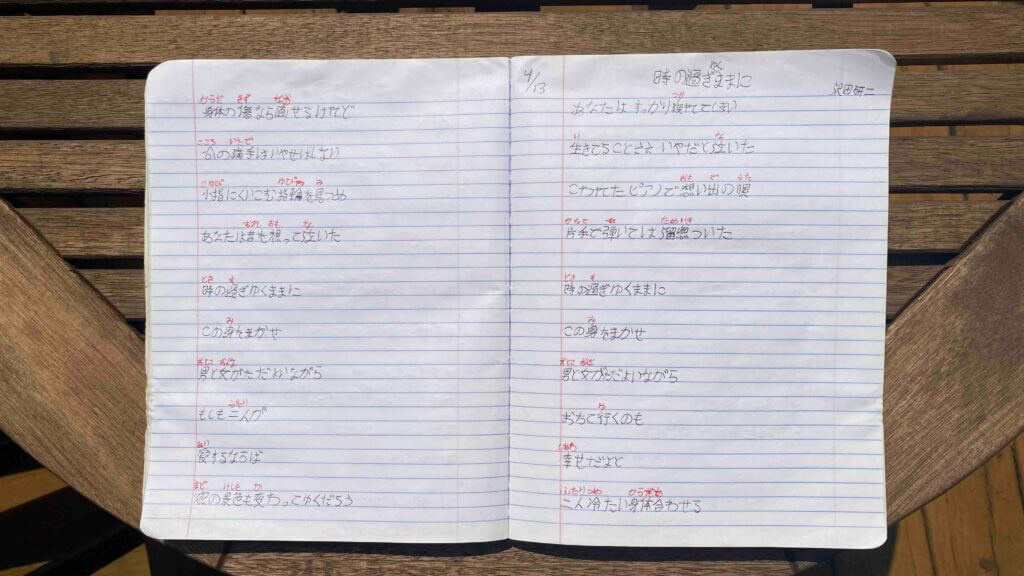
Spaces
It’s worth noting with music lyrics, spaces are commonly used to show lyrical separation or phrasing.
I would suggest listening to the song while you’re planning how to space out your lyrics so that you can arrange the spacing in accordance to the music!
Repeats
When a phrase repeats itself word for word, I personally just write it down once with a note for how many times it’s repeated (like x3).
Watch out for when a repeat changes just a few lines like in the example above 時の過ぎゆくままに. The choruses at lines 5 on both pages are mostly the same repeated except for the last 3 lines!
Be sure to leave space both above, between and beside the lyrics to use for study notes later! You’ll need them!
How To Learn Japanese Lyrics // #3 Furigana for Kanji
Now that we’ve got the raw lyrics in front of us, we need to find out how to pronounce them! Grab a colourful (erasable) pen and your dictionary and let’s dive in!
This is your first round of looking up words!
You can glance at the Kanji meaning when you’re looking up the readings, but we don’t want to overwhelm ourselves with too much info at once!
Let’s take this song as an example:
えいさ Eisa by ジェロ Jero
Lyrics can be found here.
With these lyrics I’ve used a red pen to put the furigana over all the Kanji. Although you could write it in Katakana, I prefer to write it in Hiragana.
If you want to be super cool you could write the furigana with the Onyomi in Katakana and the Kunyomi in Hiragana~~ but that’s entirely up to you!
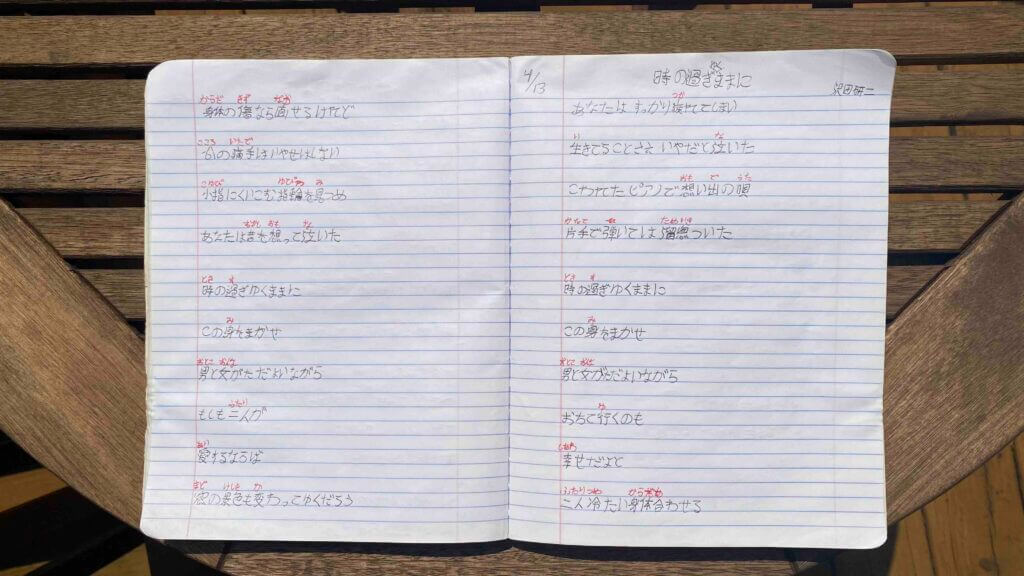
QUIZ CHANCE! When you come across a Kanji that you’ve seen before, try filling in the furigana before looking it up in your dictionary, but double check to make sure it’s the correct reading! Remember to erase it if incorrect!
Stylistic Alphabet Usage
Kanji > Stylistic Katakana
Let’s take a look at this song:
キセキ kiseki by Greeeen
Lyrics here
The song title is stylistically written in Katakana, but in the lyrics the same word 奇跡 きせき (which means miracle) is written in it’s usual Kanji.
In the 5th line of the Japanese lyrics to this song we read this:
君に巡り合えた それって『奇跡』
Artists can sometimes get creative with which Japanese script they use. Be aware of that when studying Japanese song lyrics!
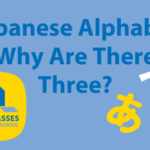
The 3 Japanese Alphabets // Discover Hiragana, Katakana and Kanji
The Japanese Alphabet is not singular. In fact there are 3 alphabets in Japanese! Hiragana, Katakana and Kanji. We teach you why and how to use them.
Katakana > Stylistic Kanji
Here we look at the song…
輪廻曲-ロンド Rondo by On & Off
Lyrics can be found here.
The title stylistically uses Kanji for a word commonly written in katakana ロンド rondo.
In fact in 輪廻曲-ロンド Rondo, three different writings for the same word めぐり are used within the lyrics, which just feels like showing off.
Beginning of the 1st chorus – 何度もつかんで 何度も失って やっと廻り合えた事
End of the 1st chorus – 永い眠りほどいて 今宵めぐり逢えたら
Middle of the 2nd chorus – 巡りゆく様に きっとこの場所を 私は選んでいたの
They all have slightly different nuances based on the Kanji the lyricist decided to use, but we won’t touch on that until the last step!
Stylistic Reading of Kanji
Digging even deeper into this song, in the 1st verse, there’s a unique reading that even has parentheses because it’s so uncommon!
光る糸を辿るように 時間(とき)は静かに流れて
Within the lyrics, the Kanji 時間 is read irregularly as とき which normally is written as 時 in Kanji.
This is most likely done in order to maintain the song’s syllable structure, so they found a shortcut to kick out a syllable and maintain the overall meaning of ‘time’.
- 時間 じかん jikan = time, hours (duration)
- 時 とき toki = time, when (timepoint)
Another example for a commonly used special reading is for the Kanji for ‘tomorrow’.
For this we move onto another song by ジェロ Jero
海雪 うみゆき UmiYuki by ジェロ Jero
Lyrics can be found here.
In the 2nd chorus we are faced with this lyric:
明日を待つ傘もなく
- 明日 あした ashita = Tomorrow
It normally reads as あした ashita
But in song lyrics, it can also read as あす asu, as is in this song.
Again, this is most likely to maintain the song’s syllable structure.
If you only look at the lyrics without listening along to the song, it may be easy to miss these instances if they are not marked. I suggest listening along with the original song while writing out the readings and see if they’re matching what they sing!
It’s important to aware that sometimes lyrics use Kanji, Hiragana or Katakana stylistically (or just to be fancy).
In instances where a word normally written in Kanji is stylistically written otherwise, I would suggest using the note space to write down the correct Kanji so that you can still learn it!

How To Learn Kanji // 7 Tips for Success 💪
How to learn Kanji? Generally, you’ll need to learn about 1,000-2,000 Chinese characters in Japanese. Here’s the best way to go about learning them.
How To Learn Japanese Lyrics // #4 Study the Lyrics
You’ve done the work of writing out the Japanese lyrics and filling in the readings, now it’s time to look up the unknown words!
This is where many lightbulbs go off and your mind starts to fill in the blanks of what you’ve been humming to this whole time!
The amount of note space you will need for this step depends on the song’s difficulty and your own range of knowledge.
This is the second round of looking up words! Now we want the meanings, so grab another (erasable) pen!
Looking Up Words
As we know now, some lyrics will have stylistic usages of alphabets which affects how we look these words up.
When inputing a word in the dictionary, try using multiple alphabets to search it.
For example:
プレイバックPt. 2 by 山口百恵 Yamaguchi Momoe
Lyrics for this Japanese song are here.
In the 1st verse we are faced with this lyric:
交差点では隣の車がミラーこすったと
The word ミラー can only be searched in Katakana. Yet in the first chorus:
これは昨夜の私のセリフ
Similar to バカ, the word セリフ can be searched in Hiragana, Katakana or Kanji.
Unique Readings
As we mentioned in step 3 for Furigana, sometimes lyrics use unique readings for Kanji, this also affects how we look up these words to find the meaning.
Going back to our previous song, in the very 1st line of the song we see this:
緑の中を走り抜けてく 真紅なポルシェ
The word 真紅 does not come up as まっか in the Imiwa? dictionary, but rather as しんく.
But when you listen to the song, she sings it as まっか!
So instead of searching with the Kanji directly, search with the sung lyrics of まっか to find the real meaning that comes up as 真っ赤 but is written stylistically in the lyrics as 真紅.
Be sure to keep listening to the song so you can catch these special readings!
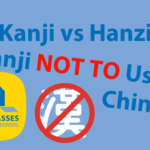
Hanzi vs Kanji // Japanese Kanji NOT To Use in Chinese
Hanzi vs Kanji // Japanese and Chinese have a long history of sharing characters with each other, but it’s not always as simple as that. Find out why…
Unique Readings
Within lyrics, sometimes you need to look at the context surrounding an unknown word to understand the phrasing.
This means trying to look up a phrase together rather than just everything individually.
Once again, going back to our previous song プレイバックPt. 2, the 2nd line of the song reads as:
一人旅なの私気ままにハンドル切るの
ハンドル by itself means wheel (or handle) and 切る by itself means ‘to cut’
However, ハンドル切る together means ‘to turn the wheel’, which wouldn’t have made sense unless searched together.
Digging deeper still, in the 1st line of the 1st chorus we see:
馬鹿にしないでよ そっちのせいよ
馬鹿 Baka by itself means ‘idiot’ and しないで shinaide by itself means ‘don’t do it’
However, 馬鹿にしないで together means ‘don’t make fun of’
Depending on the song, these can get a little complicated, but it helps to check the surrounding context of unknown words to better understand it’s meaning!
Another way I like to look up specific phrases is by directly googling it and seeing what comes up!
Googling Phrases
Sometimes a lyric is very specific and may be referencing something outside of a dictionary explanation.
Let’s take this song as an example:
カサブランカダンディ Casablanca Dandy by 沢田研二 Sawada Kenji
Lyrics here.
In the chorus we have the Japanese lyric:
ボギー ボギー
If I just look up ボギー in the dictionary, it comes up as ‘bogey’ like in golf. However, If I google ボギー, it now comes up with pictures of Humphrey Bogart (ハンフリー・ボガート).
This connects to the title of the song, “Casablanca Dandy” as Bogart starred in the movie Casablanca!
Turns out ボギー is a Japanese nick name for him! Thanks Google search. And who said language learning wasn’t a whole lot of fun!
Another example, referring back to our friend ジェロ Jero’s song えいさ Eisa from above. The 5th line of the song reads:
改札で凍て鶴だわ-
If I look up 凍て and 鶴 separately, then they come up as
- 凍て いて ite = frozen
- 鶴 つる tsuru = crane
But when I listen to the song, Jero sings it as いてづる, not つる, so there must be something more than just the separate definitions.
So I Googled…
凍て鶴 読み方 = the Yomigata for 凍て鶴
The result gave me a site that explains 凍て鶴 is a seasonal word used in haiku poems, and read as いてづる!
It also gave me a bunch of example haikus that use 凍て鶴! Fascinating stuff.
It’s so interesting what you can learn through studying a song!
Keep in mind that each song has its own variation of difficulty when it comes to studying the lyrics.
Now the remaining question is, do we actually understand the lyrics?
How To Learn Japanese Lyrics // #5 Comprehending the Lyrics
You would think that with all the vocabulary defined, it should be easy to fully comprehend the lyrics, but this is not necessarily the case (I’m looking at you again 米津玄師 Yonezu Kenshi).
Yonezu Kenshi is notorious for having fast, abstract lyrics that not even native speakers can fully comprehend songs of his like 砂の惑星 すなのわくせい.
As we touched on in Googling phrases, Japanese lyrics can use idioms, figures of speech, historical or cultural references etc.
Therefore, fully comprehending a song may feel more like extensive research than just a language lesson.
I’ve found two ways to help with this last step:
Googling It
Let’s take these lyrics as an example:
憎みきれないろくでなし にくみきれないろくでなし
nikumikirenai rokudenashi
by 沢田研二 Sawada Kenji
After looking up all the words and phrases, I was still not fully understanding the lyrics. I couldn’t pin point whose point of view the lyrics were from!
So, I looked for an explanation of the meaning behind the lyrics:
Artist + Song Name + Lyricのmeaning + ?
沢田研二 憎みきれないろくでなし 歌詞の意味?
Usually there will be Japanese blog posts about
考察 こうさつ Kousatsu (investigation), 解釈 かいしゃくkaishaku (explanation) or について (about the song/regarding).
Through my search I found this explanation blog.
After checking out this blog, I now understand that this song is set up like a conversation going back and forth between a guy and a girl. Now the lyrics make much more sense!
Such blogs can be quite linguistically advanced as they dive into the meaning behind the lyrics and explain in Japanese for Japanese speakers.
I’ve found such blogs to be a fun way to learn even more about the song’s lyrics as well as a whole extra set of study materials to learn from!

Japanese Loanwords 🤩 41 Fun Examples with Pronunciation
Japanese Loanwords are actually a great way to boost language learning motivation because it makes you realise you can still find similarities with English!
Ask a Native Speaker
This is a great way to study and bond through music at the same time!
When there are references, grammar or phrasing I don’t understand in a song’s lyrics, I’ve found it really helpful to ask a native speaker for help!
They’ve been great at providing example sentences or even explaining how to use what I’m studying!
Many times, a word that I’ve learned from a song will pop up in conversation, a product description, a movie line, or even in another song’s lyrics!
Many of the Japanese artists I listen to were introduced to me by my Japanese speaking friends, and I love to write down what songs they sing at Karaoke to learn for next time!
It’s such a delight to bond over music, sing together, and join in on the fun (as this Instagram post will prove to you)!!
BONUS CONTENT | Want to discover some songs to study Japanese with for all levels? Check out our post on learning Japanese with songs and a list of our favourites.

A Complete Guide to Learn Japanese with Songs (+ List of Best Songs)
Just like with movies and TV shows, you can learn Japanese with songs! Check out our step by step guide and a list of the best songs to listen.
How To Learn Japanese Lyrics // #6 Summing Up
There are many other unique aspects to Japanese song lyrics that I’ve run into along the way:
- The endearing use of おまえ omae (you), and rude use of あんた anta (you) when they should be opposite
- The mix of English words with Katakana words pronounced somewhere in-between
- The use of a nasal が ga, then back to a normal が ga in the same line
- When L is interestingly pronounced instead of R, despite there being no L in Japanese
- When ん is closed like M, but then becomes N again
- The distinct separation of moras (syllables) in song, then complete disregard for it
- How to sing a っ small tsu, as opposed to elongating a vowel, or are they just the same?
- When the song is in a dialect and everything I’ve learned is thrown out the window…
- How do you even learn to sing like an 演歌 えんか enka singer?
The list goes on~~~~
But I hope these 5 steps help you start learning Japanese through the songs you love!
Studying through Japanese lyrics gives you context for the vocabulary, a musical way to remember the pronunciations and readings, as well as the ability to connect with native speakers!
Keep challenging yourself and enjoy improving your Japanese through studying lyrics! It can take time, but it’s worth it!
Check out some examples to help inspire you to learn your favourite songs!
How To Learn Japanese Lyrics // FAQ’s
How do you say Song in Japanese?
Song in Japanese is 歌 (uta) or you can also use the more familiar sounding ソング (songu)
How do you say Music in Japanese?
Music in Japanese is 音楽 (ongaku). You can also use ミュージック (myujikku).
Are there many Japanese songs on YouTube I can learn?
Absolutely, there are a load, with all kinds of different genres to suit all tastes!
Can I learn Japanese through music?
Yes, and you’d be surprised how far you can get!
Studying lyrics opens up a new world of possibilities and allows you to learn things you would never learn in a textbook or general conversation.
Want More From LTL?
WANT TO LEARN JAPANESE? Check out our online Japanese courses here.
We offer a 7-day free trial to all new students where you can study 24/7.
What about studying Japanese in Japan instead? We’ve got your back. Our Japanese courses in Tokyo can either be taken in small groups of no more than 5 students or individually for a more tailored experience.
We even offer incredible homestay experiences in Tokyo as well.
Come and be a part of this amazing community.









1 comments
[…] Quote from the source: … […]